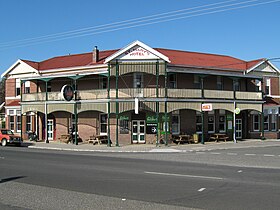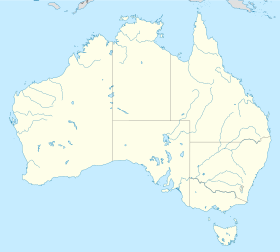St. Marys (Tasmania)
| St. Marys | |||||||
|---|---|---|---|---|---|---|---|
 St. Marys Hotel |
|||||||
|
|||||||
|
|||||||
|
|||||||
|
|||||||
|
|
|||||||
St. Marys is a small town in the northeast of the Australian state of Tasmania . It is located at the junction of Elephant Pass Road (A4) from Esk Highway (A4), about 10 km from the east coast of the island. The distance to Hobart is 240 km, after Launceston km 130th
It is now separated from the coast and the Tasman Highway (A3), which used to run through the city, by the Elephant Pass or the St. Marys Pass . The city lies below St. Patrick's Head , a 694 m high, rocky mountain.
At the 2006 census, the population was found to be 522. and by the beginning of the 21st century, the city was one of the fastest growing in Tasmania. St. Marys is located in the valley of the Break O'Day River and belongs to the local government area Break O'Day Municipality .
There you will find a number of accommodation options, an art gallery, a bakery, shops and supermarkets, as well as the St. Marys Hotel , built in 1916, which dominates the city center.
history
The first contact of a European with the area came from Captain Tobias Furneaux , who in 1773 saw and named the 694 m high St. Patrick's Head . The region around St. Marys played no role in the early settlement of Tasmania (then Van Diemens Land).
It was not until the 1840s that a parole for 300 convicts was established in Grassy Bottom (between what is now St. Marys and St. Marys Pass). The convicts were instructed to build a road through the mountains to the east coast. This took place between 1843 and 1846.
From 1866 the new railway line made the settlement more important as a service center. The Elephant Pass Road was completed in 1888 and was used to transport goods to the east coast to Bicheno and Chain of Lagoons . This in turn led to an increase in the population because St. Marys now served as a supply station for the surrounding dairy farms.
The railway line that was once so important for the city has now been abandoned, only the station is still standing.
tourism
The area around St. Marys has many attractions to offer: climbing at St. Patrick's Head or the more easily accessible South Sister Peak , as well as wonderful views of the forest and the coast from there and also from Elephant Pass.
The Coalminers Heritage Wall and Coalminers Heritage Walk at the small Cornwall settlement commemorate the miners who handcrafted tunnels in the Mount Nicholas Range .
A visit to the nearby waterfalls, a fishing trip to Lake Leake or a hike through Douglas Apsley National Park are also recommended.
Way to St. Patricks Head
The road runs east from St. Marys. Where the climb begins, turn right where Irish Town Road goes up. This road soon becomes a dirt road and you follow the signs. The ascent is not for the inexperienced; some places have wire rope insurance. But the view from the summit is terrific and a real reward for the effort.
Path to South Sister Peak
Take German Town Road and turn left at the South Sister Signpost . The climb is much easier than on St. Patrick's Head and the lookout point is a 10-15 minute walk from the parking lot.
Christ Church and Cullenswood
The Christ Church is a peculiar small church in the middle of the open field a few kilometers west of St. Marys. The church was built in 1847 and was part of a large estate called Cullenswood , founded in the late 1820s by Robert Vincent Legge , who arrived in Van Diemens Land in 1827. The Cullenswood manor house was built in 1845 and is on the road to Cornwall off Esk Main Road . It is a two-story Georgian-style house built from rubble. It has a porch with columns and a tin-covered hip roof, but is not open to the public.
In December 2006, a forest fire destroyed the area.
Individual evidence
- ↑ St Marys (Clive Street) . In: Daily rainfall . Bureau of Meteorology . Retrieved December 29, 2009.
- ↑ a b Australian Bureau of Statistics : St Marys (L) ( English ) In: 2016 Census QuickStats . June 27, 2017. Retrieved April 3, 2020.

